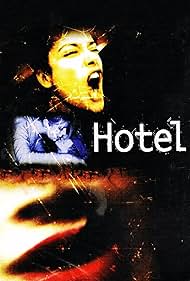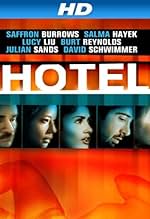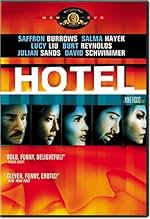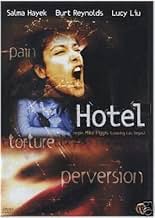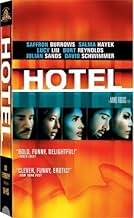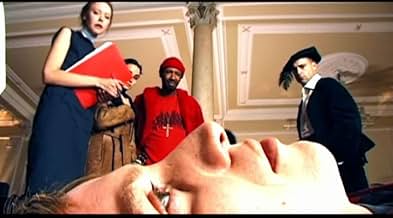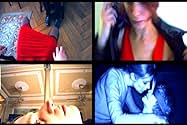IMDb RATING
4.1/10
2.2K
YOUR RATING
A sex worker, a hired killer, and a movie crew cross paths in a Venice hotel where human meat is on the menu in this freewheeling film.A sex worker, a hired killer, and a movie crew cross paths in a Venice hotel where human meat is on the menu in this freewheeling film.A sex worker, a hired killer, and a movie crew cross paths in a Venice hotel where human meat is on the menu in this freewheeling film.
- Awards
- 2 nominations
- Director
- Writers
- All cast & crew
- Production, box office & more at IMDbPro
Storyline
Did you know
- TriviaJohn Webster's play "The Duchess of Malfi" was first performed in 1614 at the Globe Theatre in London, and first published in 1623. The onscreen credits simply list the title followed by the author's name, and omit the word "play".
- ConnectionsReferences Citizen Kane (1941)
Featured review
Normally, what I appreciate above all else is the long form, the composition as a whole, rendered cinematically.
That means you need some overarching vision, some single controlling mind, some coherent narrative. It also means in general that actors can only be trusted to fill some corners of the thing and never see the whole shape because of their local concerns.
But there are only so many grand arches that can come of a coherent vision. You need a genius to escape this: a Grrenaway, Ruiz, Medem.
Even then, you know what the vocabulary will be. Its the sense that shapes the thing: narrative always is connected by causal links and long form knots.
Now I introduce you to another approach, much riskier. It reads more difficultly but is at least as rewarding, and today for me... more.
The strategy is rather simple: hand pick some exceptionally interesting actors, actors who are aware of their short horizon in the long form. Assemble them under an ever so brief outline and have them invent the narrative. Now, normally you would expect incoherence. But these folks being up on the edge understand this business of folding, layering and nesting narrative. This allows them to create smaller bits and overlay them, avoiding the pitfalls of episodes.
We have the movie. It is about the making of a movie of a play. The play is about plays, specifically about Shakespeare, and deals with decomposition and internalization. On that you have a documentary about the making of the internal film, and in parallel an interview show (these by two warring women). This all takes place in a hotel, the cellars of which host the subconscious drivers for the play within, including cannibalism.
Over this, you have the director, who arranges his own shooting, coma and resulting disembodied state where he becomes our viewer, our camera.
Now nest all of these each in the others. And where possible, show simultaneous action in two or four panes. Afterward, have the (real) director write a score that embodies the thing one of the most effective scores I know, incidentally.
It works. It works spectacularly. One element is of course the shape that has been given to it after the actors went home. But what gives this the juice is the way each layer has grown out of the imagination of the players. Its the only time I've trusted undirected actors, and it works because every node, every connector, every leap in this thing is conceived locally. There is no overall governing logic except the general acknowledgement of the eye (and mouth). Each group of actors grew the logic they use locally, out of their spirits and urges.
Its a collection of residue from disparate urges, unified by deep self-reference... what's not to like?
I am so bowled over by how powerful this is that I am making it one of two films from that year that I deem essential viewing. It, alas, bumps one of the previous selections, the inside-out "The Pledge."
Ted's Evaluation -- 4 of 3: Every cineliterate person should experience this.
That means you need some overarching vision, some single controlling mind, some coherent narrative. It also means in general that actors can only be trusted to fill some corners of the thing and never see the whole shape because of their local concerns.
But there are only so many grand arches that can come of a coherent vision. You need a genius to escape this: a Grrenaway, Ruiz, Medem.
Even then, you know what the vocabulary will be. Its the sense that shapes the thing: narrative always is connected by causal links and long form knots.
Now I introduce you to another approach, much riskier. It reads more difficultly but is at least as rewarding, and today for me... more.
The strategy is rather simple: hand pick some exceptionally interesting actors, actors who are aware of their short horizon in the long form. Assemble them under an ever so brief outline and have them invent the narrative. Now, normally you would expect incoherence. But these folks being up on the edge understand this business of folding, layering and nesting narrative. This allows them to create smaller bits and overlay them, avoiding the pitfalls of episodes.
We have the movie. It is about the making of a movie of a play. The play is about plays, specifically about Shakespeare, and deals with decomposition and internalization. On that you have a documentary about the making of the internal film, and in parallel an interview show (these by two warring women). This all takes place in a hotel, the cellars of which host the subconscious drivers for the play within, including cannibalism.
Over this, you have the director, who arranges his own shooting, coma and resulting disembodied state where he becomes our viewer, our camera.
Now nest all of these each in the others. And where possible, show simultaneous action in two or four panes. Afterward, have the (real) director write a score that embodies the thing one of the most effective scores I know, incidentally.
It works. It works spectacularly. One element is of course the shape that has been given to it after the actors went home. But what gives this the juice is the way each layer has grown out of the imagination of the players. Its the only time I've trusted undirected actors, and it works because every node, every connector, every leap in this thing is conceived locally. There is no overall governing logic except the general acknowledgement of the eye (and mouth). Each group of actors grew the logic they use locally, out of their spirits and urges.
Its a collection of residue from disparate urges, unified by deep self-reference... what's not to like?
I am so bowled over by how powerful this is that I am making it one of two films from that year that I deem essential viewing. It, alas, bumps one of the previous selections, the inside-out "The Pledge."
Ted's Evaluation -- 4 of 3: Every cineliterate person should experience this.
- How long is Hotel?Powered by Alexa
Details
- Release date
- Countries of origin
- Official sites
- Languages
- Also known as
- Отель
- Filming locations
- Production companies
- See more company credits at IMDbPro
Box office
- Gross US & Canada
- $29,813
- Opening weekend US & Canada
- $12,840
- Jul 27, 2003
- Gross worldwide
- $35,588
- Runtime1 hour 33 minutes
- Color
- Sound mix
Contribute to this page
Suggest an edit or add missing content

